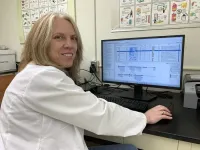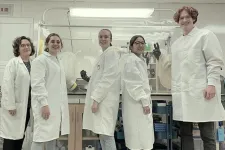(Press-News.org) Captive tigers in the United States outnumber those living in the wild. The World Wildlife Federation estimates around 5,000 of the big cats reside in the U.S., mostly owned by private citizens.
The health of this population is a genetic mystery for conservation groups and researchers interested in how the captive tigers could help stabilize or restore wild tiger populations. Are the privately owned animals just like tigers in the wild, or do they reflect characteristics popular in the illegal trade? Are they a hodgepodge of wild tiger ancestry, or are they detrimentally inbred?
New research from Stanford University, published Sept. 19 in Proceedings of the National Academy of Sciences, digs into these questions and offers a new tool that conservationists and law enforcement can use to protect the animals and prosecute those responsible for their abuse.
“We’re trying to leverage genomic technology to be useful in a conservation context – there are so few tigers. We won’t get a second chance if they go extinct,” said Ellie Armstrong, PhD ’21, who is lead author of the paper.
An unknown population
The study was led by Armstrong, who conducted the research as part of her doctoral studies in biology, with her co-advisors and co-authors Elizabeth Hadly, the Paul S. and Billie Achilles Professor in Environmental Biology, Emerita, and Dmitri Petrov, the Michelle and Kevin Douglas Professor, both in the School of Humanities and Sciences.
The researchers became interested in studying the genetic diversity of privately held tigers – called “generic” because their sources are unknown – after conducting a study on the genetic impact of the isolation of wild tiger populations.
“We were conducting a large study on wild tiger populations and leveraged these data to address the issue of captive tigers in the United States. It was a bit unbelievable, at first, that you could have a tiger living right next door and not know it,’” said Armstrong, who is now an assistant professor of evolution, ecology, and organismal biology at the University of California, Riverside. “We got connected with Tigers in America, and that’s when we realized that there’s an enormous number of these cats outside of accredited facilities that were bred for animal encounters, performed as circus animals, or were trafficked as exotic pets. But we didn’t have any idea what kind of tiger they were or where they came from.”
A hurdle for the research team was the absence of official data on generic tigers. Shows like Netflix’s 2020 Tiger King and the 2009 documentary The Tiger Next Door helped grow public knowledge of the problem of privately owned tigers, but accessing the animals for research purposes was still a challenge.
“There was so much hearsay associated with this captive population and a lot of it contradicts itself. People said, ‘All of the cats are really inbred,’ or ‘All of the cats are genetically diverse,’” said Armstrong. “We had no idea what to expect and thought that genomic technology could help us answer some of these questions.”
Building a genetic database
Through relationships with sanctuaries that had rescued generic tigers, the team obtained samples and learned about the tigers, including the rescue locations for many animals.
The researchers collected samples from 154 generic tigers and used another 100 available wild tiger samples existing in the National Center for Biotechnology Information (NCBI) database. From their previous work, the team knew that there are six wild subspecies of tigers. With these data, they developed a reference panel for tigers that was used to accurately distinguish individual animals and assign their genetic ancestry. Armstrong compares it to the popular genetic ancestry tests for humans.
“When we do 23andMe, we’re not sequencing the whole genome – we’re sequencing a portion of it that informs us about your health and ancestry,” she said. “That’s what we want to be able to do, but for tigers. It’s difficult and expensive to sequence and analyze a whole genome, especially in a conservation context. The workflow we built allows you to sequence a portion of the genome and get answers about the tiger individual and its ancestry.”
A boon to law enforcement
Knowing a tiger’s ancestry has uses beyond conservation and breeding programs – law enforcement can use it to prosecute.
The Big Cat Public Safety Act went into effect Dec. 20, 2022, ending the private ownership of big cats as pets and placing restrictions on breeding, commerce, possession, and use of certain species, including tigers. (Individuals who owned cats prior to the law passing must register the animals.) Still, the U.S. Fish and Wildlife Service has storerooms full of confiscated tiger pelts, bones, teeth, etc., and cases they are unable to prosecute because they are unable to positively identify the origin and ancestry of the samples. The agency has already requested to work with the researchers.
“We’ll be working with law enforcement to try to apply this in a forensic context to prosecute wildlife crimes like those seen in Tiger King, monitor the populations in the U.S., and track the illegal trade,” Armstrong said. “Materials like teeth and pelts have limited DNA in them, and the reference panel we built here can allow wildlife agencies to determine the ancestry and identity of confiscated samples, even by only sequencing a small portion of the genome. That’s been the most rewarding part of this research – we know that this work mattered and has immediate future applications.”
Putting rumors to rest
As for those wondering, “What are these animals?” the researchers feel they can put this question to rest. The U.S. captive tiger population did not show widespread inbreeding relative to wild tiger populations. Nor did they show that the generic tigers maintain single subspecies ancestry as is true of zoo-bred tigers or tigers in the wild. These generic tigers are a mix of different tiger subspecies. Armstrong and colleagues also show that the non-zoo captive tiger population in the United States does not harbor more genetic diversity than that found in wild populations.
“This absence of unique genetic diversity in captive tigers means that there will be no ‘genetic rescue’ of wild tigers with individuals now in captivity,” Hadly said. “In other words, the genetic diversity of wild tigers is all that evolution has to work with going into the future.”
DNA is the only way to identify a tiger subspecies – there are no distinguishable physical differences in the six recognized subspecies. If the unique evolutionary histories of individual tiger subspecies remain a priority for tiger management, and we can overcome the enormous hurdles of releasing captive animals back into the wild, the reference panel could be used to identify individuals that do not have mixed ancestry.
Said Armstrong, “This technology is usually a ‘for fun’ thing for humans, to find out more about your genetic ancestry, but we can use genomics in a very serious way to help our wildlife populations thrive in the wild and keep them from being exploited.”
Additional Stanford co-authors of this research include former CEHG/NSF postdoctoral fellow Jazlyn A. Mooney, now Gabilan Assistant Professor at the University of Southern California in the Department of Quantitative and Computational Biology; former postdoctoral scholar Katie Solari; professor emeritus of genetics Gregory Barsh; genetics researcher Christopher B. Kaelin; postdoctoral scholar Bernard Y. Kim; doctoral student Victoria Grant; Noah Rosenberg, the Stanford Professor in Population Genetics and Society and professor of biology in the School of Humanities and Sciences; and researcher Tsuya Yokoyama. Hadly is also a member of Stanford Bio-X, a senior fellow at the Stanford Woods Institute for the Environment, and a Howard Hughes Medical Institute professor. Petrov is also a member of Bio-X, the Maternal & Child Health Research Institute, the Stanford Cancer Institute, and the Stanford Woods Institute for the Environment.
Other co-authors of this work are from HudsonAlpha Institute for Biotechnology, the Hebrew University of Jerusalem, Gencove Inc., the San Diego Zoo Wildlife Alliance, and the National Centre for Biological Sciences, India.
This research was funded by a National Science Foundation Graduate Research Fellowship Program.
END
Can captive tigers be part of the effort to save wild populations?
2024-09-19
ELSE PRESS RELEASES FROM THIS DATE:
The Ocean Corporation collaborates with UTHealth Houston on Space Medicine Fellowship program
2024-09-19
UTHealth Houston and The Ocean Corporation are collaborating on UTHealth Houston’s Space Medicine Training Fellowship program, which now includes a two-week intensive training focused on hyperbaric technologies and analog environments akin to those astronauts experience during extravehicular activities (EVAs), or space walks.
The training will enhance the hands-on learning experience of fellows in the Space Medicine Fellowship program, giving them a deeper understanding of physiological and medical challenges encountered in extreme environments.
“Integrating ...
Mysteries of the bizarre ‘pseudogap’ in quantum physics finally untangled
2024-09-19
By cleverly applying a computational technique, scientists have made a breakthrough in understanding the ‘pseudogap,’ a long-standing puzzle in quantum physics with close ties to superconductivity. The discovery, presented in the September 20 issue of Science, will help scientists in their quest for room-temperature superconductivity, a holy grail of condensed matter physics that would enable lossless power transmission, faster MRI machines and superfast levitating trains.
Certain materials involving copper and oxygen display superconductivity (where electricity flows without resistance) at relatively high — but still frigid — temperatures below ...
Study: Proteins in tooth enamel offer window into human wellness
2024-09-19
A new way of looking at tooth enamel could give scientists a path to deeper understanding of the health of human populations, from the ancient to the modern.
The method, published this week in the Journal of Archaeological Science, examines two immune proteins found embedded in human tooth enamel: immunoglobulin G, an antibody that fights infection, and C-reactive protein, which is present during inflammation in the body.
“These proteins are present in tooth enamel, and they are something we can use to study the ...
New cancer cachexia treatment boosts weight gain and patient activity
2024-09-19
Researchers discovered a drug that safely and effectively helped cancer patients when they suffered from cachexia (ku-KEK-see-uh), a common condition related to cancer that involves weight loss and muscle wasting.
The results of the randomized phase 2 clinical trial, which included187 individuals who experienced cachexia with lung, pancreatic, or colorectal cancer, were reported in the New England Journal of Medicine on Sept. 14, 2024. Richard Dunne, MD, MS, a Wilmot Cancer Institute oncologist and cachexia expert was part of the large group of investigators ...
Rensselaer researcher receives $3 million grant to explore gut health
2024-09-19
Blanca Barquera's investigation into the energy-generating processes of Bacteroides, the most abundant member of the gut microbiome, and their impact on our well-being holds the promise of significant advancements in human health. Barquera is a professor at Rensselaer Polytechnic Institute in the Departments of Biological Sciences and Chemistry and Chemical Biology.
In recent years, it has become increasingly clear that an unhealthy gut is more than just a source of digestive troubles. A healthy ...
Elam named as a Fellow of the Electrochemical Society
2024-09-19
Jeffrey Elam, senior chemist, Distinguished Fellow, and founder of the atomic layer deposition (ALD) research program at the U.S. Department of Energy’s Argonne National Laboratory, was named as a fellow of the Electrochemical Society (ECS), which focuses on advancing theory and practice at the forefront of electrochemical and solid-state science and technology. Elam, who has been with the lab since 2002, has been a trailblazer in thin film coating science and technology for over 20 years, ...
Study reveals gaps in access to long-term contraceptive supplies
2024-09-19
Oregon Health & Science University researchers have found that despite legislation in 19 states requiring insurers to cover a 12-month supply of contraception, patients aren’t receiving a year’s worth of their prescription; most receive just three months or less.
Their study recently published in the journal JAMA Health Forum shows that policies requiring coverage of a 12-month supply of short-acting hormonal contraception — most commonly the birth control pill — have not been fully implemented, resulting in no substantial increases nationally in year-long prescription orders. This leaves many patients at an increased risk for unintended ...
Shining a light on the roots of plant “intelligence”
2024-09-19
All living organisms emit a low level of light radiation, but the origin and function of these 'biophotons' are not yet fully understood. An international team of physicists, funded by the Foundational Questions Institute, FQxI, has proposed a new approach for investigating this phenomenon based on statistical analyses of this emission. Their aim is to test whether biophotons can play a role in the transport of information within and between living organisms, and whether monitoring biophotons could contribute to the development of medical techniques for the early diagnosis of various diseases. Their analyses of the measurements of the faint glow emitted by lentil ...
Scientists identify a unique combination of bacterial strains that could treat antibiotic-resistant gut infections
2024-09-19
Antibiotic-resistant bacterial infections often occur in patients with chronic inflammatory intestinal conditions, such as inflammatory bowel disease, and in patients who have taken antibiotics for a long time. Gram-negative bacteria such as Enterobacteriaceae are a common cause of these infections and have few treatment options. Fecal microbiota transplants have shown promise to curb some of these infections, but their composition varies between batches and they aren’t always successful.
Researchers at Keio University School of Medicine in Tokyo and the Broad Institute of MIT and Harvard have isolated ...
Pushing kidney-stone fragments reduces stones’ recurrence
2024-09-19
Sometimes all it takes is a little push.
That is the conclusion of a recently published study in which doctors used a handheld ultrasound device to nudge patients’ kidney-stone fragments.
As many as 50% of patients who have kidney stones removed surgically still have small fragments remaining in the kidneys afterward. Of those patients, about 25% find themselves returning for another operation within five years to remove the now-larger fragments.
UW Medicine researchers found, however, that patients ...




